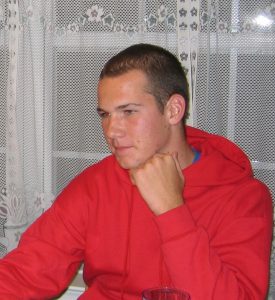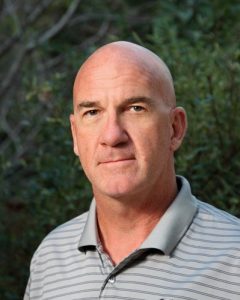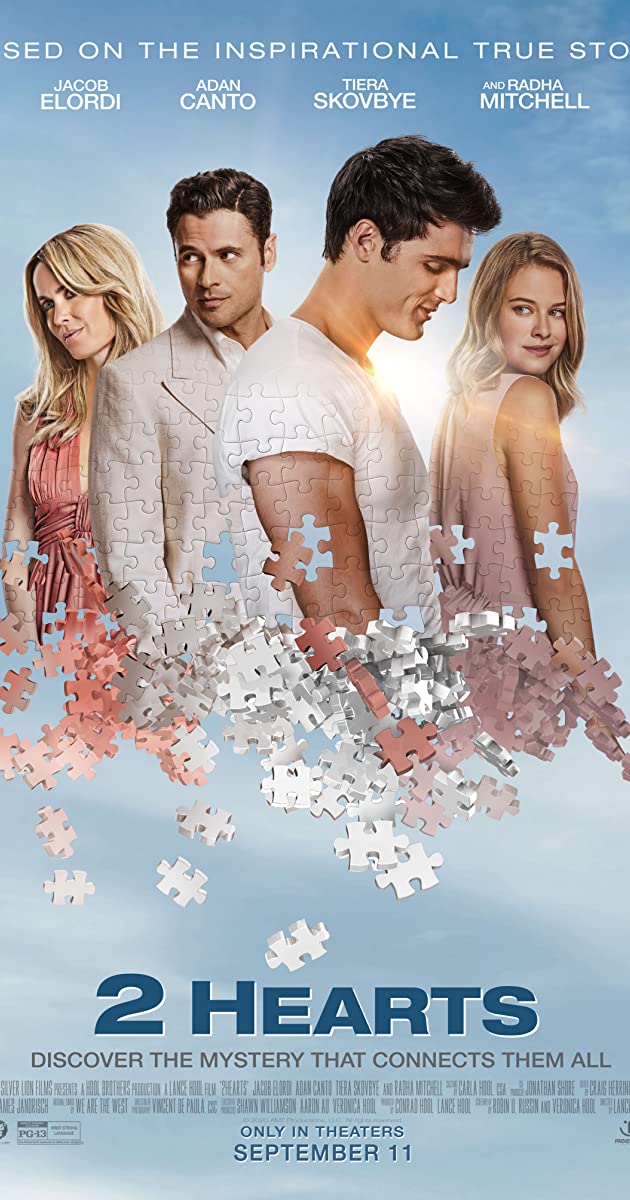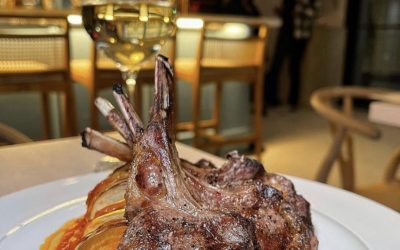It was a cloudy summer afternoon. I was home alone, surfing the television, in need of an uplifting movie to watch. After a few minutes too long of no luck, I resorted to a scroll on Instagram. The first post that popped up was one by Netflix, promoting a new film, “2 Hearts”. The main character in the teaser was recognizable: it was Jacob Elordi, the rising star from HBO’s “Euphoria”, and Netflix’s “The Kissing Booth”.
Without hesitation, I queued up the film, given zero context of the plot. “This seems like a simple, light romantic comedy for my relaxed Sunday,” I thought. Two hours later, I was uncontrollably sobbing, irreparably moved by this less-than-simple film. Two days later, I jumped on my email to get in touch with anyone I could that was a part of it. Two weeks later, I heard back from three important men. I sat down to begin writing this story. I felt as though it needed to be spread.
2 Hearts, 2 Intertwined Lives
Jorge Bacardi was born on April 6, 1944, with primary ciliary dyskinesia, a debilitating lung disease. He was also born into his family’s business: Bacardi rum, which produced spirits for 150 years. Jorge met Leslie Bacardi when she was a Pan Am air hostess. They later married. By the age of 64, Jorge’s life was slipping from his fingers. He was in need of a new set of lungs.
Christopher Mark Gregory was born on December 13, 1988. He was raised in Maryland, with his two older brothers, and his mother and father, Eric and Grace. Chris attended Loyola University in New Orleans, where he completed his first and only semester of college. In the middle of his second, Chris suffered a ruptured brain aneurysm. He was later pronounced braindead.

The real Chris Gregory
On March 27, 2008, Jorge and Leslie received a phone call. There was a match found. Jorge would receive Chris’s lungs. Under 24 hours after the transplant, Jorge was walking around the hospital, without a breathing tube. The nurses dubbed him “Superman”.
Soon after his lung transplant, Jorge and Leslie Bacardi gave funds to Mayo Clinic and founded Gabriel House of Care, a nonprofit hospitality house for families awaiting an organ donation. Gabriel was the pseudonym the Bacardis used for Chris until they learned his real name.
What Could Have Been
2 Hearts follows two true love stories that lasted a lifetime. One of Jorge and Leslie, and that of Chris and his college girlfriend, who is referred to as Sam in the film. The plot fantasizes about what Chris’s life might have looked like if he had lived on. But unfortunately, it stops short and continues on in another body. In Jorge’s, and in the other six other recipients of Chris’s organs.
The Story Heard ‘Round The World
After speaking with Robin Russin, the co-writer, the director, Lance Hool, and Chris Gregory’s father, Eric Gregory, it became very clear to me that I was not the only one who was so touched by the film. Each three of these men remarked on how people from all over the world reached out to them individually, sharing how moved they were by the story.
The story is a kismet entanglement of and stunning example of right place right time. Not only in the plot of the film, but in the way that all of the puzzle pieces came together to bring the project to fruition.
Robin Russin

Robin Russin
Robin Russin was the co-writer on “2 Hearts”. He is a screenwriter, playwright, and director. He studied at Harvard, Oxford, The Rhode Island School of Design, and UCLA. He is currently a professor at UC Riverside. He was approached by Lance Hool to work on this story.
Marley Gifford: How did you first hear about Chris Gregory’s story?
Robin Russin: Lance Hool approached me about it after his brother Conrad met Jorge Bacardi while on vacation and learned of the lung transplant and how he and the Gregorys got to know each other. I’d worked with Lance on several other projects, and he thought I had the right sensibility for this story. As it progressed, Veronica Hool brought in the idea of exploring the life Chris might have had, but never got the chance to.
MG: What moved you to want to be a part of the film, “2 Hearts”?
RR: I loved this story from the start because it was so moving, both sad and yet uplifting—how out of an unimaginable tragedy, a new friendship emerged. More than that—it was as if through this shared trauma these two families became one, and truly came to love each other.
MG: What sets it apart from other films in its genre right now?
RR: I think, as mentioned, it is different because — other than the fantasy sequence of the life Chris might have had — it is based on the generosity, courage, and decency of these real people. I really fell in love with these people myself.
MG: Did the actors in the film, like Jacob Elordi (Chris) and Adan Canto (Jorge), bring to life what you had co-written in the way you had imagined?
Yes, absolutely— they felt so real and so appropriate to the characters they were portraying. I also want to give a shout-out to Tahmoh Penikett, who perfectly embodied Eric, Chris’s father. But they were all great, and all so on-target with their representations.
MG: This must have been a big success for you, to have a film that you have co-written debut on Netflix? What was that like?
RR: A bit surreal, to tell the truth. I’ve been working in the film business for a long time, but often on projects that never got this kind of response. I’m hearing from people around the world, how moved and inspired they were by the film. I really owe Lance a great debt of gratitude for believing in me and involving me in the film.
MG: What message do you want viewers to take away from the “2 Hearts” film? What lessons did you learn through your journey with the film?
RR: I want people to come away from the film with the feeling that life is short, precious, and unpredictable— but that through love and sacrifice, life can achieve [greater] meaning and purpose than anyone could imagine. I want people to realize that even in death, a gift of life can be given to others, and that grief can be transformed into love.
Lance Hool
Lance Hool directed “2 Hearts”. He has also worked as a writer, executive producer, distribution company chairman, studio chief, and actor. He has produced over twenty-five major motion pictures. Two of which have reached number one at the US box office; “Missing in Action” and “Man on Fire”.
MG: How did you first hear about Chris Gregory’s story?
Lance Hool: My brother Conrad met and befriended one of the couples. He told me their story and asked if I saw a movie in it.
MG: What moved you to want to direct “2 Hearts”?
LH: My first impulse was: this is a great story but a very, very tough movie to make. How do we tell the story of two couples that are so far apart in age and in time? And how do we keep the mystery going of how they get together through a whole 100-minute film? I told him: “This is not in our wheelhouse.” “Man on Fire”, “Missing in Action”, those movies were. And if it was a comedy, “Pure Luck” and “Crocodile Dundee”. But this one was something that I’d been looking for for a long time, which was a story that was really deep in the human aspect of our lives. And so he convinced me, “You can make a great movie out of this story.” And so I jumped into it. Fully dressed, into the swimming pool. I was looking for a human story that was real.
MG: What sets “2 Hearts” apart from other films in its genre right now?
LH: It is a film that relies entirely on human relationships. There are no bad guys, no guns, it is based on pure love.
MG: What was it like working with the actors in the film, like Jacob Elordi and Adan Canto? Did they bring to life your vision for 2 Hearts?
LH: Because it is such a unique story, I always felt that I needed to have actors that weren’t known. You have to get so involved with the character as an audience, the worst thing is to say, “Oh look, there’s Tom Cruise playing a doctor” or whatever. You just can’t get divorced from that for a while, so you’re out of the story. I wanted to capture every character so that the audience could easily identify with [it] immediately. So it was a six-month period of casting, in which we interviewed hundreds of people.
I had an extremely set vision that I saw throughout the film. The first character I cast was the only “known” actor, Radha Mitchell, whom I had worked with in”Man On Fire”. She is a terrific actress who I knew would immediately create a base for all the actors. Jacob Elordi was very green and took a lot of work but was a pleasure to be around, and Adan Canto is a revelation. A tremendous actor and [a] great human being. The other actress with a huge future is Tiera. I worked with a great cast and they performed beautifully. The screenplay is exceptional.
MG: Congratulations on 2 Hearts Reaching Top 10 in the U.S. on Netflix! That must be a gratifying feeling, is it?
LH: It hit number one. We are all thrilled at the millions of people who have seen the film and love it. It is very gratifying.
MG: What message do you want viewers to take away from the “2 Hearts” film? What lessons did you learn through your journey with the film?
LH: Take every moment of your life as it could be your last. Leave a legacy. Remember always that you can’t take it with you and do your absolute best to do good and love.
Eric Gregory

Eric Gregory
Eric Gregory is the father of the late Chris Gregory. Less than four years after the death of his son, he wrote “All My Tomorrows: A Story of Tragedy, Transplant, and Hope.” In 2014, Jorge Bacardi met Conrad Hool, Lance’s brother and eventual producer of the film. From there, the manuscript was turned into “2 Hearts”. Eric carries on the legacy of his son through this story.
MG: What compelled you to open your heart and write your son’s story, “All My Tomorrows”, years after the passing of your son, Chris?
Eric Gregory: The project actually began in February 2012, less than four years after Christopher’s death. By then, we had become close friends with Jorge and Leslie Bacardi and met most of the other four recipients of Christopher’s organs. In the back of my mind, there was always the biological clock; that they might not survive long enough to see this project’s completion. It took me five years to finally get it into print.
Beginning with Jorge and Leslie, among the first questions I asked each of these unique individuals (when we met) was “where were you when you got the call” that an organ was available for them? In Jorge’s case, he received two calls in the same evening, an extremely rare event. But as they each told us of the incredible events surrounding their transplants I started to overlay their experiences with our own. For instance, Nic was sent home (to die) after his failed angiogram about the same time that the second neurological exam confirmed Chris was truly brain-dead. Jorge was waking up from surgery about the time we were cleaning out Chris’ dorm room.
It seemed to me that everyone’s stories were intertwined and really interdependent upon each other. That’s when I thought it was a story that deserved to be told and I tried to convey this when I constructed the narrative of the book.
I really felt like I owed it to Chris to tell his story. I just hoped that I had the perseverance and writing skills to pull it off. I wanted to celebrate my son’s too-short life, promote the cause of organ donation and maybe offer some hope to other grieving parents since this was their story as much as mine.
MG: When did you first learn that your story was going to become a movie? What was that experience like?
EG: I believe in 2014 Jorge Bacardi called me and said that he had met a movie producer while on a cruise ship in the Pacific. The producer was Conrad Hool (Man on Fire), Lance’s brother. During their conversation, Conrad learned of Jorge’s transplant, about Chris, and about the friendship that was developing between the Bacardis and us. Basically, I was in disbelief. Jorge said, “I told him he needs to talk to you because you’re writing a book about it.”
Grace and I went to Santa Fe and met Conrad and discovered how serious he was. So I told Conrad that whenever I had a manuscript completed I would share it with him.
I can tell you that the research and writing process was an emotional roller-coaster and not the cathartic experience people assume it to be. There were many, many moments when I said, “I just can’t do this.” And then I’d get a call from Jorge, “Hey Boss. How’s that book coming? Conrad wants to know when he might get to read it.” And I’d throw myself back into the project.
I assure you thirteen years ago we never imagined talking about books or movies or any of this in the present context. It is very bittersweet and it isn’t lost on us that most donor families do not share this kind of experience.
MG: When did you watch “2 Hearts” for the first time? Were you with your family? Were you emotional when you watched the film for the first time?
EG: We saw it for the first time at a screening in Los Angeles. The Bacardis were there with some of their family and friends. Grace and I flew out from our home in Arizona. I was stunned by how well Jacob Elordi captured Christopher’s mannerisms and spirit.
I have seen the movie six times. I get emotional every time because, while some creative license was taken, the movie is still very true to the real story. So much of the dialogue comes from actual conversations and situations. I have heard from people who were actually there (at the hospital) saying that it is difficult to watch.
Lance told me after the screening, “Thank you for trusting us with your son’s story.” I have never regretted doing so. The Hool family always took care to treat Christopher with respect and to portray the subject of organ transplantation accurately. That meant a lot to us. It was the same meeting the cast and crew. They seemed genuinely invested in the story.
MG: I love the sentiment behind the letters that Jorge sent you and your family, and how he said he was “with Chris” when he was doing something like going fishing. What does that mean to you?
EG: I should mention that Jorge passed away in September but we remain close to his family, especially Leslie. I loved getting those letters and we still love hearing from Leslie or any of their family. They are always special. Those first letters were what stopped our downward spiral and let us know that we could survive the loss of our son.
We were told by the organ procurement agency that we shouldn’t expect to hear from anyone for years maybe. And even then we shouldn’t expect too much. But those first letters and e-mails, Leslie calls them the “love letters,” did more to help us heal than I can describe.
MG: It is clear that Chris’s story has made an impact, and will continue to now that this film is getting out there more. How does that make you feel?
EG: Grateful. Humble. I am getting e-mails from people I’ve not met saying how much Christopher’s story has touched them. It means his life hasn’t really ended and that his love remains very much in this world. Especially when folks tell us that they signed up as an organ donor. That’s why your interview is so important. Most people register to be organ donors at their local motor vehicle administration office. But because New York has so few drivers compared to the rest of the country, they have a smaller donor base but a greater need for organ donors.
While the movie features Chris, it is about donors everywhere. They’re all so young and they die so suddenly. Justin Harrison was only fifteen. Tim Susco was twenty-four. Dru Mayon was ten. Their deaths were unexpected and they left behind holes in their families that can never be filled. Their parents didn’t get to plan their weddings. They had to plan their funerals instead. But somebody else lived because those kids died and that has to count for something. They didn’t die for [no reason]. I think the movie makes that point.
You know each of us has a story and we tell our story in the way we live our life. Well, Chris never got to finish his story. So I tried to tell his story through the medium of print. And now Lance and Robin and the cast and crew have told his story through the medium of film. And that means his story will be told forever because cinema is art and art doesn’t die. The craft of storytelling is powerful and compelling and permanent.
MG: What do you think Chris would say about having his story shared with the world right now?
He wouldn’t say anything. He would just get a wry grin on his face that meant he knew something the rest of us didn’t.
The Importance of Organ Donation Specifically in New York
Chris’s father imparted to me the need for organ donation in the state of New York; a region in which there are fewer drivers than in other states, meaning less opportunity for organ donors, in a state in dire need of organs. If you reside in New York, or anywhere else, consider checking the organ donor box the next time you can. Any opportunity to save a life is one worth taking.
Visit organdonor.gov to make the choice that could save a life, or seven, just like Chris.
For more Downtown Q&A, click here.













